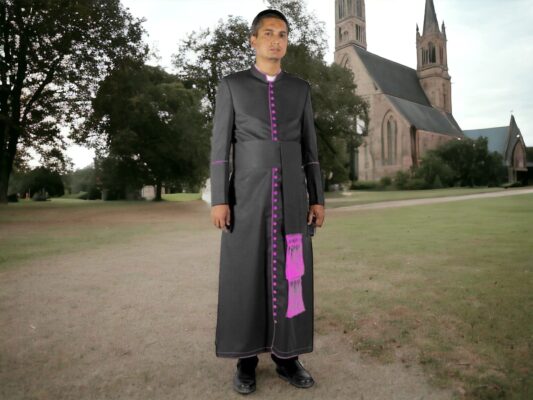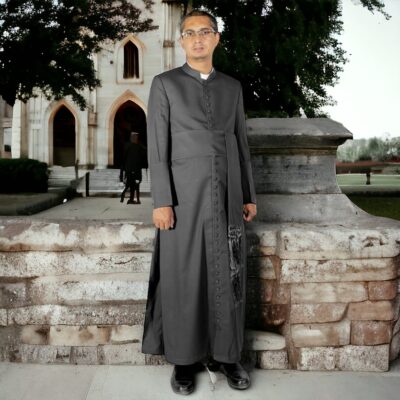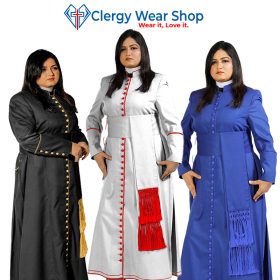Clergy Robes for Men
Exquisite Classic Black Priest Robe Special Occasions
Why Do Priests Wear Black Cassock?
The traditional attire of priests has long been a subject of curiosity and fascination. One of the most iconic elements is the Black Cassock worn by clergy members in various religious traditions. Here we will delve into the historical, symbolic, and practical aspects of why priests choose to don the black cassock.
What is a priest’s cassock
A Priest’s Cassock is a distinctive, ankle-length robe worn by Clergy Members, particularly in Christian denominations. Typically black, the cassock is a symbol of religious devotion and humility. It is often paired with a white clerical shirt featuring a detachable collar, and a band cincture serves as a belt. The Cassock is not merely a garment; it holds historical, symbolic, and practical significance. Originating from centuries-old traditions, the cassock is worn during liturgical ceremonies and everyday activities, representing a priest’s commitment to their religious vocation and serving as a visible emblem of their role within the community.
Historical Significance of the Black Cassock
The roots of the Priest Attire can be traced back to centuries-old traditions within religious communities. Initially adopted as a symbol of humility and simplicity, the black cassock became a staple in the wardrobes of clergy members.
Black, in the context of religious symbolism, often represents penance, humility, and mourning. The Minister Attire, being a significant part of clerical attire, carries these symbolic meanings into various religious ceremonies.
 Liturgical Importance | Role in Various Ceremonies
Liturgical Importance | Role in Various Ceremonies
The clergy cassock plays a crucial role in numerous liturgical ceremonies, adding a sense of solemnity and reverence. Its usage is not limited to specific rituals but extends to a priest’s everyday life.
Within religious rites and sacraments, the clergy robes becomes a visual representation of the priest’s commitment to serving a higher purpose. Its presence is deeply intertwined with the spiritual significance of these events.
Practical Considerations
Apart from its symbolic importance, the cassock for mens is favored for its practical aspects. Its loose and flowing design provides comfort, especially during long ceremonies, while its simple elegance makes it a versatile choice for various occasions.
The meticulous care taken in maintaining the black cassock also holds symbolic meaning. It reflects the priest’s commitment to his role and serves as a visible reminder of the responsibilities associated with the clergy.
Variations and Styles
While the basic design remains consistent, there are variations in the style and cut of cassocks across different religious denominations. Understanding these differences adds depth to the appreciation of clerical attire.
The color, length, and additional accessories may vary based on regional practices and denominational traditions. Exploring these nuances provides insight into the diverse world of religious attire.
Contemporary Interpretations
In the face of evolving societal norms, there have been adaptations in clerical attire. Some clergy members choose modern interpretations, incorporating elements of the Preacher Attire into contemporary fashion.
The perception of clergy members in society has undergone shifts over the years. Understanding how the black cassock fits into these changing perceptions provides a glimpse into the dynamic nature of religious traditions.
Social and Cultural Impact
The attire of clergy members often shapes public perception. The clergy cassock, in particular, carries a certain gravitas that influences how religious leaders are viewed in the broader social context.
Examining the role of clerical attire in interfaith relations offers insights into the potential impact on dialogue and understanding among different religious communities.
Challenges and Criticisms
In contemporary times, there may be resistance to the adherence to traditional attire. Addressing these challenges requires a delicate balance between respecting tradition and embracing change.
Clerical attire, including the black cassock, can be subject to misconceptions. Dissecting these misunderstandings helps in fostering a better understanding of the significance behind religious vestments.
Role of Cassocks Beyond Religion
The influence of religious attire, including the Pastor Attire, extends beyond the realm of spirituality. Exploring its presence in art and popular culture unveils its impact on broader societal aesthetics.
The elements of clerical attire often find their way into mainstream fashion. Analyzing the influence of cassocks on fashion trends provides a unique perspective on the intersection of tradition and contemporary style.
Common Questions About Cassocks
Why Do Priests Wear Black Cassock?
The choice of black for cassocks is deeply rooted in religious symbolism, representing humility and penance.
Can any priest wear a cassock?
Not every priest is required to wear a cassock, as it depends on the specific traditions and regulations of their religious denomination. While many clergy members, especially in Christian traditions, opt for the symbolic and traditional attire of a cassock, it is not a universal mandate. Some priests may choose different forms of clerical attire or follow specific guidelines set by their respective religious authorities. The decision to wear a cassock often reflects individual preferences, denominational practices, and the level of formality associated with their religious roles.
What is worn underneath a cassock?
Underneath a cassock, priests typically wear a white clerical shirt with a detachable clerical collar. This shirt is long-sleeved and buttoned up, and it provides a formal and dignified appearance. The detachable collar, usually white, stands upright and is a distinctive feature of clerical attire. Additionally, priests wear a band cincture, a cord-like belt, around the waist. The choice of undergarments, such as trousers or slacks, may vary depending on personal comfort and local customs. The ensemble is designed to maintain a modest and respectful appearance in line with religious traditions. Why Do Priests Wear Black Cassock?

 Clergy Cassocks for Men
Clergy Cassocks for Men Clergy Cassocks for Women
Clergy Cassocks for Women Clergy Robes for Women
Clergy Robes for Women Clergy Shirts for Men
Clergy Shirts for Men Clergy Shirts for Women
Clergy Shirts for Women